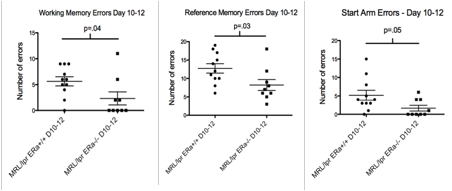Session Information
Session Type: Abstract Submissions (ACR)
 Background/Purpose: Up to 80% of SLE patients have cognitive defects or affective disorders. The mechanism of CNS injury responsible for cognitive impairment is unknown. Anti-dsDNA antibodies crossreacting with NMDA receptors in the brain mediate excitotoxic cell death, causing behavioral changes in lupus–prone mice. A breach in the blood-brain barrier (BBB) is required for these effects. Data suggest that BBB breakdown, pathogenic autoantibodies, and subsequent neuronal damage in key areas are critical to the development of neuropsychiatric SLE. We previously showed that estrogen receptor alpha (ERa) deficiency significantly reduced renal disease and increased survival in murine lupus. We hypothesized that ERa also plays a role in modulating BBB integrity and/or neuroinflammation leading to CNS dysfunction in lupus prone MRL/lpr mice. Methods: MRL/lpr lupus mice (n=28) were ovariectomized at 4wks, received 90d-release estradiol pellets at 6wks, and underwent behavioral testing beginning at 8wks with radial arm water maze (RAWM) and novel object recognition (NOR). Mice were sacrificed at 12wks, or after re-testing at 20wks. Hippocampus, pre-frontal cortex, ventral striatum and parietal cortex were dissected. Western blotting and IHC were used to evaluate tight junction proteins, BBB and inflammatory mediators. Results: MRL/lpr ERa-/- mice (n=9) performed significantly better in RAWM testing than WT MRL/lpr mice (n=11). There was a significant reduction in working memory errors (2.33 vs. 5.64, p=0.041), reference memory errors (8.22 vs. 12.73, p=0.033) and start arm errors (1.67 vs. 5.18, p=0.048) in ERa-/- mice at 8-10wks. There were no significant differences in NOR testing in discrimination index or latency to novel object, but ERa-/- mice spent significantly more time with both objects compared to WT MRL/lpr. Eight of 20 brains were processed and analyzed to date, with no significant differences seen in tight junction proteins (Zo-1 or occludin), however there is a trend towards reduced Zo-1 in hippocampus and cortex from ERa-/- mice. GFAP (astrogliosis marker) was not significantly different between groups, but there was a trend towards reduced Iba1 (microgliosis marker) in hippocampus. Conclusion: Preliminary data suggest a trend towards reduced microgliosis as a marker of inflammation in the hippocampus of ERa-/- mice. Most notably, ERa deficiency provides profound protection against cognitive deficits in MRL/lpr mice as early as 8wks of age.
Background/Purpose: Up to 80% of SLE patients have cognitive defects or affective disorders. The mechanism of CNS injury responsible for cognitive impairment is unknown. Anti-dsDNA antibodies crossreacting with NMDA receptors in the brain mediate excitotoxic cell death, causing behavioral changes in lupus–prone mice. A breach in the blood-brain barrier (BBB) is required for these effects. Data suggest that BBB breakdown, pathogenic autoantibodies, and subsequent neuronal damage in key areas are critical to the development of neuropsychiatric SLE. We previously showed that estrogen receptor alpha (ERa) deficiency significantly reduced renal disease and increased survival in murine lupus. We hypothesized that ERa also plays a role in modulating BBB integrity and/or neuroinflammation leading to CNS dysfunction in lupus prone MRL/lpr mice. Methods: MRL/lpr lupus mice (n=28) were ovariectomized at 4wks, received 90d-release estradiol pellets at 6wks, and underwent behavioral testing beginning at 8wks with radial arm water maze (RAWM) and novel object recognition (NOR). Mice were sacrificed at 12wks, or after re-testing at 20wks. Hippocampus, pre-frontal cortex, ventral striatum and parietal cortex were dissected. Western blotting and IHC were used to evaluate tight junction proteins, BBB and inflammatory mediators. Results: MRL/lpr ERa-/- mice (n=9) performed significantly better in RAWM testing than WT MRL/lpr mice (n=11). There was a significant reduction in working memory errors (2.33 vs. 5.64, p=0.041), reference memory errors (8.22 vs. 12.73, p=0.033) and start arm errors (1.67 vs. 5.18, p=0.048) in ERa-/- mice at 8-10wks. There were no significant differences in NOR testing in discrimination index or latency to novel object, but ERa-/- mice spent significantly more time with both objects compared to WT MRL/lpr. Eight of 20 brains were processed and analyzed to date, with no significant differences seen in tight junction proteins (Zo-1 or occludin), however there is a trend towards reduced Zo-1 in hippocampus and cortex from ERa-/- mice. GFAP (astrogliosis marker) was not significantly different between groups, but there was a trend towards reduced Iba1 (microgliosis marker) in hippocampus. Conclusion: Preliminary data suggest a trend towards reduced microgliosis as a marker of inflammation in the hippocampus of ERa-/- mice. Most notably, ERa deficiency provides profound protection against cognitive deficits in MRL/lpr mice as early as 8wks of age.
Disclosure:
M. A. Cunningham,
None;
O. S. Naga,
None;
H. A. Boger,
None;
A. C. E. Granholm-Bentley,
None;
G. S. Gilkeson,
None.
« Back to 2012 ACR/ARHP Annual Meeting
ACR Meeting Abstracts - https://acrabstracts.org/abstract/estrogen-receptor-alpha-deficiency-protects-against-cognitive-defects-in-murine-lupus/
